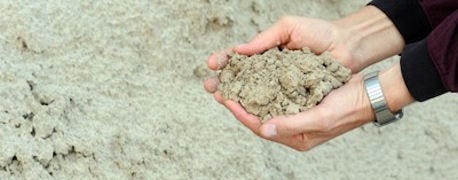January 16, 2013

Warren Dick, a soil biochemist at OSU's College of Food, Agricultural, and Environmental Sciences, says applying fluidized gas desulfurization gypsum to crop fields can keep soluble phosphorus, the main nutrient feeding the algae, from getting washed from the soil by heavy rains, then running off into streams and rivers and eventually into the lake.
"Not only that, but FGD gypsum, which is a synthetic form of gypsum, can improve both the soil and the crops," he says. "Naturally occurring, mined gypsum has a long history as a soil amendment and fertilizer for farming."

Warren Dick holds a double handful of FGD gypsum, which is powdery and resembles flour. (K.D. Chamberlain image.)
Dick is part of a national program to develop agricultural uses for FGD gypsum, which comes from the air-emission scrubbers at coal-burning power plants. The scrubbers remove sulfur dioxide, which would cause acid rain, from the plants' exhaust emissions. The process creates large amounts of quality gypsum as a byproduct.
FGD gypsum is powdery, resembles flour, and can be applied using conventional farm spreaders. It costs about $35 to $50 per ton spread on the field, with a typical application rate being one or two tons per acre every two or three years. A growing number of farmer co-ops sell it.
Locally, Dick's research focuses on northwest Ohio's Maumee River watershed, which is the largest watershed draining into Lake Erie and is the lake's largest contributor of nonpoint source pollution. Nonpoint source pollution is pollution that comes from many, spread-out sources.
His recently funded project in the Maumee watershed will test FGD gypsum on fields that have high soluble phosphorus levels, will collect soil and water samples from the fields to determine the material's effects, and will compare crop yields from treated and untreated fields.
The study's results will contribute to refined recommendations for farmers and should lead to wider and more-effective use of FGD gypsum, he says.
Partners on the project include utility companies, crop consultants and scientists from other universities.
Excess soluble phosphorus is the primary cause of the huge and sometimes toxic algal blooms that have plagued Lake Erie and other water bodies, such as western Ohio's Grand Lake St. Marys, the past few years, experts say. It comes from fertilizer and manure runoff from farms, sewer overflow from storms, discharge water from wastewater treatment plants, and leaking septic systems. Wide use of gypsum could slash the portion that comes from farms, Dick says.
"Based on various studies, gypsum can cut the amount of soluble phosphorus running off soils by 40 to 70%," he says.
When spread on a field, gypsum binds in the soil with phosphorus to make calcium phosphate, which is a much less soluble form of phosphorus. This means it's less able to run off in water.
"But gypsum is also an excellent source of sulfur nutrition for plants for improving crop yields," Dick says. "It interacts with nitrogen to make it more efficient. And it interacts with the soil itself.
~~~PAGE_BREAK_HERE~~~"It aggregates the soil, which improves its structure, and improves aeration and water infiltration, which reduces runoff. It allows water to move into the soil but doesn't keep the soil waterlogged so that air can move into the soil and allow the crops to grow well."
In previous studies, Dick has documented a nearly 7-percent increase in corn yields from using gypsum and an 18% jump in alfalfa tonnage.
"Plants are getting more and more deficient in sulfur," he says, one reason being that the coal-plant scrubbers are working. Over the past 30 years, Ohio has seen nearly a 40% drop in how much sulfur rains down on the ground, according to the National Atmospheric Deposition Program.
"If you continue to harvest huge amounts of alfalfa off a field, if you harvest corn grain or soybean grain, you're removing a lot of sulfur every year. If you never put anything back, eventually you start to run deficits," Dick says.
Nitrogen-fixing crops, such as soybeans and alfalfa, have an especially high sulfur requirement, he says.
"(FGD) gypsum is a readily available, less-expensive source of sulfur," Dick says. "And there's a lot of research now across the U.S. showing that crops are becoming more responsive to sulfur as a nutrient fertilizer input.
"Gypsum provides calcium, too, which can stimulate plant root growth and help crops reach more water and nutrients."
Gypsum also can allow farmers to use conservation tillage practices, such as no-tillage, on the Maumee watershed's heavy clay soils, which often don't lend themselves well to the methods, he says. This would cut soil erosion into Lake Erie, boost carbon sequestration by the farms' soils, and let farmers spend less money on tillage equipment and fuel.
Using gypsum on corn, for instance, could increase yields by about five bushels an acre, and at a conservative price of $5 per bushel "would almost pay for itself the first year," Dick says.
An OSU Extension bulletin that Dick co-authored, called "Gypsum as an Agricultural Amendment," can be purchased through OSU Extension's eStore or downloaded free here(pdf).
You May Also Like




